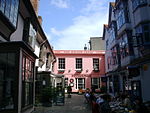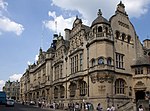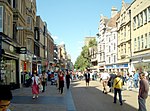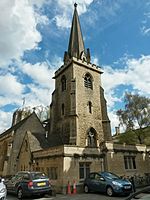Carfax, Oxford
Buildings and structures demolished in 1896Former churches in OxfordGrade II listed buildings in OxfordHistory of OxfordRoad junctions in England ... and 5 more
Squares in OxfordTourist attractions in OxfordTowers in OxfordTransport in OxfordUse British English from March 2017

Carfax is the junction of St Aldate's (south), Cornmarket Street (north), Queen Street (west) and the High Street (east) in Oxford, England. It is considered to be the centre of the city. The name "Carfax" derives from the Latin quadrifurcus via the French carrefour, both of which mean "crossroads". The Carfax Tower, also known as St. Martin's Tower (it is the remaining part of what was the City Church of St. Martin of Tours) is a prominent landmark and provides a look-out over the town.
Excerpt from the Wikipedia article Carfax, Oxford (License: CC BY-SA 3.0, Authors, Images).Carfax, Oxford
Carfax, Oxford City Centre
Geographical coordinates (GPS) Address Nearby Places Show on map
Geographical coordinates (GPS)
| Latitude | Longitude |
|---|---|
| N 51.752 ° | E -1.2577 ° |
Address
Santander
Carfax
OX1 1HB Oxford, City Centre
England, United Kingdom
Open on Google Maps









